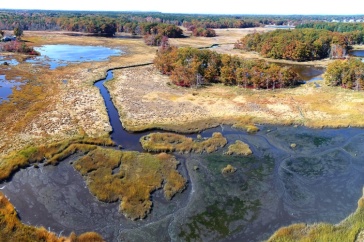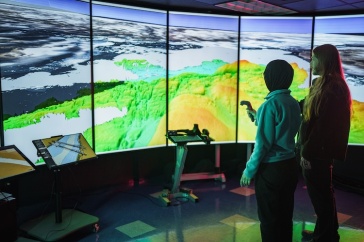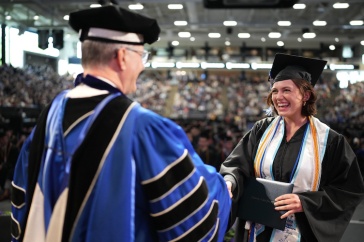

"I’m really proud of the fact that it’s not just about hard science,” says Cameron Wake, a research professor at the Institute for the Study of Earth, Oceans and Space. “That’s a huge strength of our URC — all disciplines have the opportunity to share their research. It’s not just about people in lab coats.”
The URC is very much not about lab coats. Research projects, which can take a semester or even a year to complete, are presented orally or via posters at various places around campus that aren’t laboratories — the Whittemore Center, Paul College, the MUB. Subjects range from molecular biology to MFA exhibitions and bridge replacements and computer network security and investing and the feminine voice in literature and — so much more.
And then there are the relationships, Wake says. Specifically, those forged between students and the research advisors who shepherd them through the process of collecting and analyzing data and who provide a broader understanding of what their findings mean.
“The mentor relationship is a critical step in the URC’s success. It is likely the singular most significant experience we can offer students,” Wake says. “Having a mentor encourages students to take on these bigger challenges that would likely seem daunting to them if they were going it alone. It allows them to reach for the stars.”
Those experiences have been made possible by scores of people who started talking about a large student conference more than 20 years ago. People like Wake, who chaired the URC planning commit- tee for five early years, and Lynn Cooper, the former program coordinator, and Julie Williams, senior vice provost for engagement and faculty development, about whom Wake says, “Julie had URC going and growing by the time I came onboard.” Williams calls it a collaboration of united minds with a common goal.
“We brought people together across campus who were willing to do the work, both faculty and staff,” Williams says. “There were colleges and departments doing their own presentations, and we wanted to figure out how to do more events in more places and include all majors. Right from the beginning, we knew we wanted it to be bigger, longer and give students the best experience we could give them.”
Today, the goals of bigger, longer and best have been met. Not only has student participation increased since that first year, but the number of advisors has jumped from 83 to 441 and unique events have more than doubled, from 11 to 27. Paul Tsang, director of the Hamel Center for Undergraduate Research, the group that now oversees the URC, views those statistics as a huge vote of confidence in that early idea.
“Since the first URC was held 20 years ago, we have seen a steady increase in both student presenters and faculty research advisors — a clear sign that students and faculty alike recognize the value not only of conducting research but also of communicating the findings to a broader audience,” Tsang says. “At this point, undergraduate research is truly an integral part of the culture at UNH. As we look beyond the 20th URC, I am gratified that our students continue to embrace the spirit of inquiry and discovery that drives original research.”
A sampling of projects presented by students at this year’s URC follows.


Large masses are called blooms, or, in layman’s terms, pond scum. The scientific name for the overabundance of algae that forms in lakes and ponds and streams is cyanobacteria.
Emily Ray ’20 has been studying the facts of cyanobacteria since she came to UNH, most recently during a 10-week internship at the Shoals Marine Laboratory on Appledore Island. This is her third time at the URC and her second as the student representative to the College of Life Sciences and Agriculture URC committee. Her project generated renewed excitement for her because it is the first time that cyanobacteria has been found in Crystal Lake, which is Appledore’s only source of fresh water.
“The big question was, what’s in the lake and how will it change over the summer?” says Ray. “No one had ever really looked at Crystal Lake before to know what’s in it. When I found it, I felt really accomplished. There were three species. One took over the whole lake and then another took over and then the third.”
Ray’s research involved monitoring changes in pH, dissolved oxygen, temperature, nutrient concentrations, plankton and associated pigments in the lake during a 14-week period. Dave Buck, associate director of the Shoals Marine Laboratory, took over the monitoring for the last four weeks after Ray’s internship ended and brought water samples back to UNH so she could count the plankton.
“That cyanobacteria are in the lake could have implications in the area,” says Ray, a dual major in the marine, estuarine and freshwater biology and neuroscience and behavior programs who is applying to Ph.D. programs to further her studies. “The big picture here is, fresh water is important to the island, so it’s important to study and see if there are physical changes over time that could be harmful to people and the wildlife on the island.”


Then several dams in the area breached after days of torrential rain, and much of the East village’s past was washed away.
Some of the houses and buildings were destroyed. Some were moved to other parts of town, and the rest were bulldozed in 1957 when a new dam was finished. Over time, the history of what was there slowly began to fade. Memories of gifts bought at the toy store, of people arriving at the train depot, of gatherings at the Bucket of Blood dance hall.
Boss searched for remains of the village, in the river and under the soil, using a surveying method that uses laser to measure distance. She also relied on a series of granite markers an area Boy Scout troop erected in 1993 at what are believed to be the buildings’ original locations. And she talked to town elders who had been only 5 and 6 years old when the floodwaters came. “It was very emotional for them,” Boss says. “There was one 93-year-old man who told me he was very glad that someone still cared about East Weare.”
Boss’ family is from Weare and goes back generations. Her grandfather, who still lives there, accompanied her out in the field one day when she was trying to locate a house listed on the historical society map.
“I was getting frustrated because I had no way of knowing if I was in the right place,” the anthropology major says. Then her grandfather looked up and pointed out an old tree, commenting on its age. Boss went back to the historical society map and found the tree. All of this ground truthing helped her make her own map of the area, and she ended up finding 33 of the 97 known buildings.


It was those crowds of fellow strollers — and the inviting streetscape that attracted them — that sparked Malone’s curiosity when it came time to select a research project for this year’s URC. The economics major at the Peter T. Paul College of Business and Economics was particularly interested in determining whether access to such walker-friendly downtowns made nearby homes more valuable.
His hypothesis — based in part on the fact that several New Hampshire cities and towns, including Concord and Newmarket, have recently pushed for and undergone pedestrian-friendly downtown makeovers — was that it would.
His research, though, led him to the other side of the street.
Malone studied six New Hampshire cities — Portsmouth, Dover, Manchester, Concord, Nashua and Keene — comparing walkability index scores from the Environmental Protection Agency with property values from Zillow.com and discovered no correlation between the two categories.
“I wasn’t expecting to see that at all,” Malone says. “I would have expected to see at least a little bit of a positive relationship. It’s pretty interesting — we have all these towns that are really into walkability and encouraging walking, but it doesn’t show up in the [property value] data. So, is it really something that people care about as much as we think?”
Malone isn’t quite ready to answer his own hypothetical in the negative, though. While the results implied that traditional measures of home value remain foremost in buyers’ minds — things like number of bedrooms and bathrooms, overall square footage and neighborhood location — he believes that walkability is still an “added benefit” in certain locales.
In other words, a walkable downtown may not have a tangible impact on the bottom line of real estate transactions, but it can play a significant role in attracting potential buyers. “I think there might be some relationship between social capital and walkability — the added health benefits associated with it and get- ting outside and being active,” says Malone. “I’d love to explore whether there is anything to what is considered a ‘nicer’ neighborhood being more walkable.”


When Allison Bickford ’22, Alexander Charest ’22, Matthew Gigliotti ’22 and Cassidy Wilson ’22 started in the new Innovation Scholars program in the College of Engineering and Physical Sciences last fall, none of them had any idea that springtime would find them waking up before dawn to deploy pur- pose-made sensors along Hampton’s flood-prone Hobson Avenue to measure the height of the tide.
The project had special resonance for Gigliotti, who is from Hampton and is familiar with the flooding that plagues the residential streets nearest the beach, particularly during the so-called king tides, the unusually high tides that occur roughly once a month.
“It’s something that’s always been a fact of living in Hampton,” Gigliotti says. “So when I saw this project presented during first semester and realized there
was an opportunity to study the dynamics of the flooding and possibly even play a role in helping the community address the issue, I jumped right on it.”
The team of students built waterproof ultrasonic sensors to measure water levels at various points along Hobson Avenue, which they then deployed in advance of the March king tide. When flooding receded, they compared the data they recorded to forecasts from the National Oceanic and Atmospheric Administration (NOAA). Their results suggested observed water levels that were higher than NOAA’s predictions — an outcome that might have real impli- cations for flood management activities in the area going forward, including new guidelines for which residents need to evacuate and at what point.
And while this year’s project ended with the team’s presentation to a group of judges on April 24, all four students say they hope to continue with the study into next year and beyond. In the future forecast? Laser sensors — which will yield more accurate data than their ultrasonic predecessors — an increased number of sensors and new measuring sites in the community, all of which will allow the team to build a better picture of the flooding and how it affects Hampton as a whole.


An exercise science major, Bandera set out to compare the leg strength in women over 50 who had undergone chemotherapy with that of women in the same age group who had not. The cancer survivors were between 6 months and 10 years out from treatment, with an average of 2 1⁄2 to 3 years. In addition to health factors, she looked at age, fitness, the amount of time spent exercising per week and whether that exercise was moderate or vigorous.
Bandera studied functional demand — the ratio of the muscular force required by a physical task to the maximal force capacity of the muscle — to determine whether activities like getting up from a chair are more tiring for those who have been treated for cancer with chemotherapy than for those who have not. She utilized a biomechanics method that has been employed by a handful of researchers but never on cancer survivors.
“If functional demand is high, it’s almost like sprinting,” says Bandera. “If your upper body is weak and you can’t carry a bag of groceries, that’s one thing, but if you can’t move, that impacts everything you do.”
For her URC research this year, Bandera added new subjects, and they confirmed her previous findings that showed statistically lower hip and knee extensor strength as well as statistically higher knee functional demands.
“While we do not know whether higher functional demands caused a reduction in physical activity, or whether the physical activity itself reduced functional demand, it is the first time, to our understanding, this variable is shown to have some sort of relationship with physical activity,” Bandera says.
-
Written By:
Jody Record ’95 | Communications and Public Affairs | jody.record@unh.edu

















































